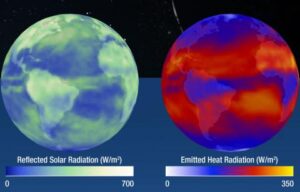Earth’s climate is changing as a result of increased solar radiation absorption: NASA. Significant variations in Earth’s absorbed solar radiation during 2023 have been revealed by recent data collection and assessment from NASA’s Clouds and the Earth’s Radiant Energy System (CERES) Energy Balanced and Filled (EBAF) Edition 4.2. These fluctuations show an uptick, particularly in February, March, and December 2023.
The data analysis highlights the possible effects of more solar energy absorption while providing insight into the continuing changes in Earth’s energy balance.
 SUN ABSORPTION OF EARTH: TRENDS AND FLUCTUATIONS
SUN ABSORPTION OF EARTH: TRENDS AND FLUCTUATIONS
Earth’s absorption of solar energy increased dramatically in 2023, reaching a high of 3.9 watts per square meter (W/m2) in February and then rising to 6.2 W/m2 in March.
When compared to historical data from the same months in 2000, these numbers show a notable difference that points to an overall upward trend in solar radiation absorption.
According to statistics from NASA’s CERES, the continuous trend of strong solar radiation absorption persisted in December 2023.
This served as yet another reminder of the continuous changes to the Earth’s energy balance, which is thought to be controlled by a variety of intricately intertwined variables, including variations in solar variability, air particulates, greenhouse gas concentrations, and albedo.
Moreover, it has been demonstrated that the calculated annual mean absorption levels for 2023 are substantially greater than those recorded at the beginning of the twenty-first century. These measurements are significant because they point to a possible trend of rising solar radiation absorption by the planet’s surface.
Temperature, sea level, and climate changes could result from the ensuing energy imbalance, illustrating the possible effects of these changes on the environment worldwide.
What factors have been fluctuating during the last few years?
An essential step in analyzing our global climate system is comprehending the type and variations of solar radiation that is absorbed on the surface of the Earth.
The examination of NASA’s CERES EBAF Ed4.2 data, which was just made public, has shed light on these modifications and patterns.
This data looks over the years 2000 to 2023 and shows a lot of variation from year to year as well as month to month.
On the other hand, the absorbed solar radiation shows a considerable upward trend in recent years, with the years 2011, 2017, 2022, and 2023 standing out as having very large surges.
This suggests that the Earth’s climate system is becoming more dynamic, and it will probably have a significant effect on how we understand energy balance and climate change.
The data does, however, also show some years with negative anomalies, including 2001 and 2014. These times show a decrease in solar absorption, which could be caused by a number of things like cloud cover, aerosols, or variations in Earth’s albedo.
Remarkably, there has been a stronger upward tendency in recent years. Particularly in 2023, the yearly mean change in absorbed solar radiation is unusually high. This highlights the increasing amount of solar radiation that the surface of the Earth is absorbing.
WHY DO CLIMATOLOGISTS NEED SUCH DATA?
For climatologists and policymakers, interpreting these shifts and patterns in absorbed solar energy is crucial. It gives us important information about how our climate is currently behaving, but it also gives us a hint as to what we might be able to expect in the future.
It is impossible to minimize the possible effects on long-term climate projections and worldwide weather patterns.
To sum up, the data from the CERES EBAF Ed4.2 emphasize how dynamic and intricate our climate system is. It also emphasizes how important it is to keep an eye on these changes and do research and in-depth analysis of them.
The ultimate objective is to acquire the knowledge required to decide responsibly about our ecological future and to help implement practical climate change solutions.
































